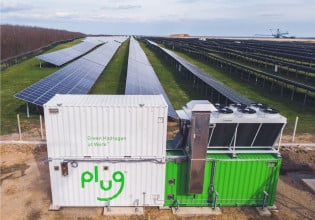Flow Battery Uses Organic Charge Storage Molecules for Long-duration Grid Storage
XL Batteries, Inc. closes $10 million in seed funding for low-cost, scalable flow battery technology based on non-corrosive organic molecules and salt water.
With their high energy density, compact size, and low weight, lithium-ion batteries are ideal for e-mobility applications like electric vehicles (EVs). Still, for grid-scale, long-duration storage applications (rated power for more than ~ 8 hours), lithium-ion storage technologies are generally not cost-effective.

Flow batteries use mild, salt-water-based chemistry. Image used courtesy of Pixabay
The good news is that long-duration applications do not place a premium on size and weight, so more cost-effective and physically larger battery technologies, like flow batteries, can be a better fit. However, to date, many existing flow battery technologies use volatile, unstable chemistries, requiring expensive components to tolerate the highly corrosive electrolytes.
Founded in 2019 based on research out of Columbia University, XL Batteries is developing flow battery technology to address these limitations. The company has closed $10 million in seed funding to advance its new flow battery solution based on a far less corrosive salt-water chemistry and can be constructed from less expensive, off-the-shelf components.
Pumped Hydro
According to XL, current grid storage capacity is less than 1% of the total energy used in the US each day. Of this limited available grid storage, about 95% is provided through pumped hydroelectric systems. Pumped hydroelectric storage uses electric powered pumps to pump water to higher elevation storage facilities, or reservoirs, where gravity can then be used to recover the energy through hydro-powered turbine generators.
While effective, this energy storage approach has a range of limitations, including the need for access to an elevated storage reservoir and the use of large tracts of land. For these reasons, hydroelectric storage is not an option in many regions and can be difficult to scale.

Pumped hydroelectric storage. Image used courtesy of XL Batteries
Flow Batteries
Lithium-ion battery chemistries are sensitive to air, limiting the size of individual battery cells. So, to construct a larger storage battery, many individual cells need to be combined in “packs,” sometimes numbering in the thousands. This assembly adds to the cost of the battery, and as the battery gets larger, the cost per unit of energy capacity increases.
Unlike lithium-based batteries, per-unit energy storage costs for flow batteries decrease as the battery size increases.
Flow batteries were invented by NASA in the 1970s and are large by design. In a flow battery, charge storage molecules are dissolved in a liquid and stored in a tank. This electrolyte is passed across electrodes to create a charge or discharge cycle.
The battery’s energy storage capacity is dictated by the size of the tank and the total amount charge bearing molecules contained within the electrolyte. The power of the battery, or the amount of electricity that can be charged or discharged over a measured period, is defined by the size of the electrodes and is independent of the battery's storage capacity.
In this manner, the duration of a battery can be extended by increasing the number of total storage electrolytes for a given electrode power configuration. Not exactly practicable for an EV, but perfectly acceptable for grid energy storage!

Flow batteries use charge storage molecules to store energy. Image used courtesy of XL Batteries
Organic Molecules for Charge Storage
The “secret” behind the XL Battery solution is using charge storage molecules made from organic materials that are non-corrosive and stable in salt water. The result is a stable, non-flammable battery that can cost-effectively scale to large-capacity storage applications.
As discussed earlier, the topology is also flexible and can be designed to accommodate durations of 8 to 24 hours in length over 1000s of cycles with an operating life of 20-plus years.
The XL team comprises scientists from Columbia University, Cornell, and other institutions with more than 100 years of combined experience in chemical design, synthesis, battery fabrication, and research on molecular behavior. The team cites their ability to invent new molecules and apply them to novel battery designs as a key competitive advantage.
Catalus Capital led the seed round with participation from Xerox Ventures and SIP Global Partners, a US-Japan VC firm investing in early-stage decarbonization technology.






